|
View this as a webpage
View past Updates via RSS Feed
Sept. 18, 2019
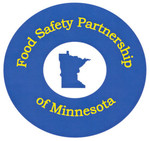
The Food Safety Partnership of Minnesota meeting on Wed., Sept. 11 was packed with information about emerging food safety concerns, current research impacting retail food safety, and even a look at inspection data under the newly adopted Minnesota food code.
For the more than 170 individuals who joined the meeting either in person or using WebEx, it was also a chance to connect with others, hear about resources and opportunities, and to share experiences. Thank you for joining in as we continue to build our strong statewide food safety culture.
|
In this and coming issues of the Update, we are highlighting a few bites of information from each of the three main topic areas at the meeting:
- Early Returns: Prevalence of Selected New Food Code Citations in MDA and MDH Routine Inspections - this issue
-
Cyclospora Outbreaks - coming soon
- Minnesota Cooling Study - coming soon
In addition, we continue to bring you Rules in Brief, which are your source to learn about:
- What has changed?
- How does the new rule protect the public's health?
- How can retail food establishment operators meet the requirements?
- Sarah and the PWDU team
As we began planning for the Sept. 11 Food Safety Partnership of Minnesota meeting, members of the FSP Steering Committee expressed interest in hearing about how well retail food establishments are complying with food code requirements. They wanted to understand where some problem areas might be, and use the FSP meeting to help provide operators and regulators with tools and resources to improve compliance.
Early Returns: Prevalence of Selected New Food Code Citations in MDA and MDH Routine Inspections
To help answer the Steering Committee’s question of how well retail food establishments are complying with the new and revised food code requirements, we were able to share some very limited data. Our presenters, Jill Herberg (MDA), Michelle Messer (MDH), and Jim Topie (MDH), shared data from Jan. through June of this year. The limitations of the data set include:
For each of the following 12 Minnesota food code requirements, Jill and Michelle shared resources that can help your establishment comply and keep food safe for your customers.
Data are drawn from a total of 7,211 routine inspections (MDA: 1,955; MDH: 5,256) conducted during the first six months under the revised Minnesota food code.
|
1. Employ a state certified food protection manager and post the CFPM certificate (1,362 citations)
|
|
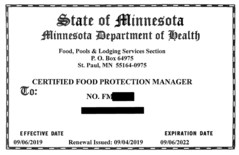 |
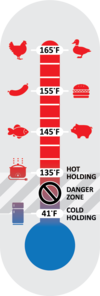 |
|
2. Keep hot food hot (135°F or above) and cold food cold (41°F or below) (1,276 citations)
- Take internal temperatures of hot and cold foods on a regular basis.
- Don’t rely on the ambient air temperature of coolers and steam tables.
- Refer to the Temperature and Time Requirements for Food fact sheet from MDA and MDH.
|
3. Date mark refrigerated ready-to-eat, time/temperature control for safety food (TCS) prepared and held for longer than 24 hours (846 citations)
- Remember to count the day of preparation as day 1.
- Serve, sell or discard date marked food within seven days.
- The Date Marking fact sheet from MDA and MDH gives more details and exemptions.
|
4. Post handwashing reminder signs wherever employees wash their hands (843 citations)
|
|
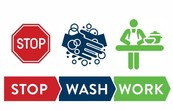 |
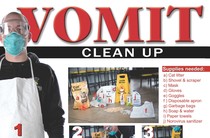
5. Establish procedures for cleaning up vomit and diarrhea (612 citations)
- You might want your procedure to identify who will clean up vomit and diarrhea, what tools, products, and protective equipment they will need, where they will dispose of contaminated items, and record-keeping.
- Olmsted County Public Health developed a Vomit Clean Up Poster you can download from the MDH website.
- Don’t forget to train your staff, especially your persons in charge (PICs), so they will know how to reduce the risk of norovirus if there is a vomiting or diarrheal incident in your establishment.
|
6. Measure temperatures of thin foods with a thin-probe food thermometer (551 citations)
- If you serve meat patties, fish fillets, or other thin food products, get a thermometer with a thin probe.
- There are lots of options, and you can use these to measure temperatures of thick foods, too!
7. Provide a consumer advisory if you serve or sell raw or undercooked animal foods as ready-to-eat foods (518 citations)
- Update your menu to inform consumers of the potential health risks from eating raw or undercooked animal food.
- Your consumer advisory must include BOTH a disclosure and a reminder.
- Review the Consumer Advisory fact sheet from MDH and MDA, which includes guidance, exact text required on your consumer advisory, and examples.

8. Purchase and use an irreversible registering temperature measuring indicator (505 citations)
- Use a waterproof max/min thermometer by turning it on and securing it in the dish rack before you start the machine. Even if you don’t read it right away, the next time you turn the thermometer on, it will display the maximum temperature for the cycle. You should be able to get many years of life out of this tool.
- Thermal color-changing stickers are another option. A bar on the sticker changes color to show the highest temperature the sticker has been exposed to. Stickers are a single-use item.
|
9. Prevent bare hand contact with ready-to-eat foods (269 citations)
- Use deli paper, spatulas, tongs, or single-use gloves when handling exposed ready-to-eat foods.
- Share the Preventing Contamination from Hands fact sheet from MDH and MDA with your employees.
10. Obtain a variance before you need one (250 citations)
- If you want to conduct specialized processing in your retail food establishment, talk to your inspector. Work together to ensure your HACCP plan and variance are approved and in place before you need them.
- Some typical processes that require a variance under the revised Minnesota food code include adding cure, wild game processing, conducting reduced oxygen packaging (ROP), and using food additives.
- Review the Specialized Processes in Retail Food Establishments fact sheet from MDA and MDH for more information.
11. Write procedures for time as public health control (232 citations)
- Your procedures must describe how you will monitor, mark, and dispose of food held using TPHC. For food prepared, cooked, and refrigerated prior to using TPHC, your procedures must also describe how you will meet safe cooling requirements.
- The Time as Public Health Control fact sheet from MDA and MDH gives examples of common situations where food establishments use TPHC, as well as situations when it is not allowed.
- Contact your inspector or call MDH at 651-201-4500 if you would like a copy of the TPHC Form and Monitoring Log that you can customize for your operations.
12. Obtain pre-approval of your written procedures for noncontinuous cooking (57 citations)
- Noncontinuous cooking means partially cooking raw animal food, properly cooling it, and then finishing the cooking process later. If you want to do this, you’ll need to write procedures and have them preapproved by your inspector.
- MDH and MDA developed a fact sheet and a form to help retail food establishment operators comply with this requirement. You can download the Noncontinuous Cooking fact sheet from the MDH website. Contact your inspector or call MDH at 651-201-4500 for a copy of the Noncontinuous Cooking Form.
Continuing education certificates
Continuing education certificates for those seeking REHS/RS credit are now available. Log into your MN.TRAIN account to view, download, and print your certificate if you registered and signed in.
Those seeking continuing education credit for Minnesota certified food protection manager (CFPM) need to submit the online quiz by going to Food Safety Partnership Summative Assessment. The quiz will be open through Oct. 11. Log into your MN.TRAIN account after Oct. 11 to view, download, and print your certificate if you registered, signed in and submitted the quiz.
|